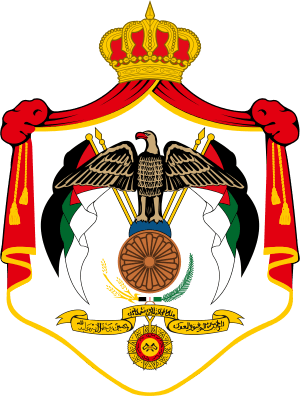Line of succession to the Jordanian throne
| Jordanian Royal Family |
|---|
 |
|
Extended royal family
|
Line of succession to the Jordanian throne is the line of people who are eligible to succeed to the throne of the Hashemite Kingdom of Jordan. The succession is regulated by Article 28 of the Constitution of Jordan.
Succession rules
The throne passes according to agnatic primogeniture. The only people eligible to succeed are mentally sound Muslim men who are legitimate and agnatic descendants of Abdullah I of Jordan. A prince must be born to Muslim parents in order to have succession rights.
The king has the right to appoint one of his brothers as heir apparent. If the king dies without legitimate heir, the throne devolves upon the person whom the National Assembly selects from amongst the descendants of Hussein bin Ali, Sharif of Mecca, the founder of the Arab Revolt.
A person can be barred from succession by Royal Decree on the ground of unsuitability. His descendants would not be automatically excluded.
Line of succession
 King Abdullah I (1882-1951)
King Abdullah I (1882-1951)
 King Talal (1909-1972)
King Talal (1909-1972)
 King Hussein (1935-1999)
King Hussein (1935-1999)
 King Abdullah II (b. 1962)
King Abdullah II (b. 1962)
- (1) Crown Prince Hussein (b. 1994)
- (2) Prince Hashem (b. 2005)
- (3) Prince Feisal (b. 1963)
- (4) Prince Omar (b. 1993)
- (5) Prince Abdullah (b. 2016)
- (6) Prince Ali (b. 1975)
- (7) Prince Abdullah (b. 2007)
- (8) Prince Hamzah (b. 1980)
- (9) Prince Hashim (b. 1981)
- (10) Prince Hussein Haidara (b. 2015)
- (11) Prince Muhammad (b. 1940)
- (12) Prince Talal (b. 1965)
- (13) Prince Hussein (b. 1999)
- (14) Prince Muhammad (b. 2001)
- (15) Prince Ghazi (b. 1966)
- (16) Prince Abdullah (b. 2001)
- (12) Prince Talal (b. 1965)
- (17) Prince Hassan (b. 1947)
- (18) Prince Rashid (b. 1979)
- (19) Prince Hassan (b. 2013)
- (20) Prince Talal (b. 2016)
- (18) Prince Rashid (b. 1979)
- Prince Naif (1914-1983)
- (21) Prince Ali (b. 1941)
- (22) Prince Muhammad (b. 1973)
- (23) Prince Hamzah (b. 2007)
- (24) Prince Ja'afar (b. 2007)
- (22) Prince Muhammad (b. 1973)
- (25) Prince Asem (b. 1948)
- (26) Prince Nayef (b. 1998)
- (21) Prince Ali (b. 1941)
List of heirs presumptive and heirs apparent throughout history
Heir apparent to Abdullah I
- 1946-1951: Talal bin Abdullah, the eldest son of Abdullah I
Heir apparent to Talal
- 1951-1952: Hussein bin Talal, the eldest son of Talal
Heirs presumptive and heirs apparent to Hussein
- 1952-1962: Muhammad bin Talal, the eldest brother of Hussein (heir presumptive)
- 1962-1965: Abdullah bin Hussein, the eldest son of Hussein (heir apparent)
- 1965-1999: Hassan bin Talal, the second brother of Hussein (heir apparent)
- 1999: Abdullah bin Hussein, the eldest son of Hussein (heir apparent)
King Hussein's brother, Prince Muhammad, was the heir presumptive to the throne until the birth of Hussein's eldest son, Abdullah. Abdullah was his father's heir apparent from his birth in 1962 until 1965, when King Hussein decided to appoint his 18-year-old brother Hassan as heir apparent because of the unstable times in the 1960s.[1]
Shortly after his marriage to Queen Noor, King Hussein instructed his brother to appoint Prince Ali (Hussein's eldest son from his marriage to Queen Alia) as his heir apparent. However, by 1992, Hussein changed his mind. Besides his own sons, the King seriously regarded his nephew, Prince Talal bin Muhammad, as his possible heir. Finally, on 25 January 1999, shortly before his death, Hussein proclaimed Abdullah his heir apparent again and was succeeded by him on his death.[2]
Heirs apparent to Abdullah II
- 1999-2004: Hamzah bin Al Hussein, the third brother of Abdullah II (by decree)
- 2004–present: Hussein bin Al Abdullah, the eldest son of Abdullah II (2004-09 by Constitution; 2009- by decree and Constitution)
References
- Robins, Philip: A History of Jordan Cambridge University Press 2004 ISBN 0-521-59895-8